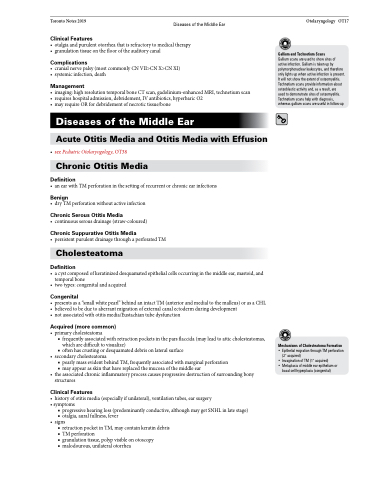Page 1003 - TNFlipTest
P. 1003
Toronto Notes 2019 Diseases of the Middle Ear
Clinical Features
• otalgiaandpurulentotorrheathatisrefractorytomedicaltherapy • granulationtissueontheflooroftheauditorycanal
Complications
• cranialnervepalsy(mostcommonlyCNVII>CNX>CNXI) • systemicinfection,death
Management
• imaging:highresolutiontemporalboneCTscan,gadolinium-enhancedMRI,technetiumscan • requireshospitaladmission,debridement,IVantibiotics,hyperbaricO2
• mayrequireORfordebridementofnecrotictissue/bone
Diseases of the Middle Ear
Acute Otitis Media and Otitis Media with Effusion
• seePediatricOtolaryngology,OT38 Chronic Otitis Media
Definition
• anearwithTMperforationinthesettingofrecurrentorchronicearinfections
Benign
• dryTMperforationwithoutactiveinfection
Chronic Serous Otitis Media
• continuousserousdrainage(straw-coloured)
Chronic Suppurative Otitis Media
• persistentpurulentdrainagethroughaperforatedTM
Cholesteatoma
Definition
• acystcomposedofkeratinizeddesquamatedepithelialcellsoccurringinthemiddleear,mastoid,and temporal bone
• twotypes:congenitalandacquired
Congenital
• presentsasa“smallwhitepearl”behindanintactTM(anteriorandmedialtothemalleus)orasaCHL • believedtobeduetoaberrantmigrationofexternalcanalectodermduringdevelopment
• notassociatedwithotitismedia/Eustachiantubedysfunction
Acquired (more common)
• primarycholesteatoma
■ frequently associated with retraction pockets in the pars flaccida (may lead to attic cholesteatomas,
which are difficult to visualize)
■ often has crusting or desquamated debris on lateral surface
• secondarycholesteatoma
■ pearly mass evident behind TM, frequently associated with marginal perforation ■ may appear as skin that have replaced the mucosa of the middle ear
• theassociatedchronicinflammatoryprocesscausesprogressivedestructionofsurroundingbony structures
Clinical Features
• historyofotitismedia(especiallyifunilateral),ventilationtubes,earsurgery • symptoms
■ progressive hearing loss (predominantly conductive, although may get SNHL in late stage)
■ otalgia, aural fullness, fever • signs
■ retraction pocket in TM, may contain keratin debris ■ TMperforation
■ granulation tissue, polyp visible on otoscopy
■ malodourous, unilateral otorrhea
Otolaryngology OT17
Gallium and Technetium Scans
Gallium scans are used to show sites of active infection. Gallium is taken up by polymorphonuclear leukocytes, and therefore only lights up when active infection is present. It will not show the extent of osteomyelitis. Technetium scans provide information about osteoblastic activity and, as a result, are
used to demonstrate sites of osteomyelitis. Technetium scans help with diagnosis, whereas gallium scans are useful in follow-up
Mechanisms of Cholesteatoma Formation
• Epithelial migration through TM perforation (2° acquired)
• Invagination of TM (1° acquired)
• Metaplasia of middle ear epithelium or
basal cell hyperplasia (congenital)


